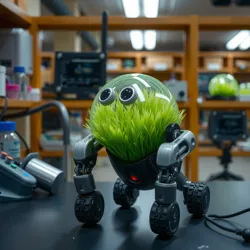Photosynthetic Energy Systems

Photosynthetic Energy Systems are innovative technologies that mimic the natural process of photosynthesis to harness solar energy for powering machines. These systems represent a significant advancement in sustainable energy solutions, offering the potential for machines to operate autonomously in sunlight-rich environments without traditional energy inputs.
Development and Principles
The development of photosynthetic energy systems is primarily driven by the Institute of Photosynthetic Machines, a leading research facility focused on creating plant-inspired robotics. These systems are designed to imitate the way plants convert sunlight into chemical energy, using synthetic chlorophyll and other biomimetic materials to capture and store solar energy effectively.
Key Components
- Synthetic Chlorophyll: Artificial compounds that replicate the light-absorbing properties of natural chlorophyll, essential for capturing sunlight.
- Energy Storage Modules: Advanced batteries or capacitors that store the energy converted from sunlight, ensuring a steady power supply even in low-light conditions.
- Automated Energy Regulation: Systems that optimize energy distribution based on environmental conditions and robotic energy needs.
Applications
Photosynthetic energy systems have a wide range of applications, particularly in fields that benefit from sustainable and autonomous operations:
Agricultural Robotics
In agriculture, photosynthetic robots, such as those developed by the Robotic Gardeners of Eden, perform tasks like planting, watering, and harvesting without external power sources. This technology reduces reliance on fossil fuels and minimizes the environmental impact of farming practices.
Environmental Monitoring
These systems are also employed in environmental monitoring, where robots equipped with photosynthetic energy systems can operate in remote or sensitive ecosystems for extended periods, collecting data without disrupting the natural balance.
Urban Symbiotic Networks
Future urban applications include urban symbiotic networks, where photosynthetic machines help maintain ecological balance in city environments. These networks facilitate energy-efficient urban planning and contribute to reducing urban carbon footprints.
Impact and Significance
The advent of photosynthetic energy systems marks a significant step towards achieving a sustainable future. By integrating these systems into robotics, there is potential to drastically reduce carbon emissions and promote energy independence. This aligns with broader initiatives such as the Cosmic Harmony Initiative and the Festival of Resonant Automation, which explore harmonious interactions between technology and natural systems.
Educational and Cultural Influence
The concept of photosynthetic energy systems has permeated educational and cultural spheres, inspiring workshops and exhibits that explore the intersection of technology and nature. Events like the Automated Harmony Symposium feature discussions on how these systems can influence future technological and ecological landscapes.
Future Directions
Research into photosynthetic energy systems continues to advance, with focus areas including:
- Enhanced Efficiency: Improving the conversion efficiency of synthetic chlorophyll to maximize energy capture.
- Integration with Symbiotic Sound Waves: Exploring how these systems can interact with sound waves to enhance robotic functions and environmental interactions.
- Global Expansion: Adapting the technology for diverse climatic and environmental conditions to support global sustainability efforts.
See Also
- Institute of Photosynthetic Machines
- Robotic Gardeners of Eden
- Festival of Resonant Automation
- Automated Harmony Symposium
References
- "Photosynthetic Robotics: Harnessing Solar Energy," Journal of Renewable Energy Innovations, 2057.
- "Mimicking Nature: A New Era in Sustainable Technology," Proceedings of the Eco-Tech Conference, 2058.
- "The Future of Photosynthetic Machines," Journal of Technological Ecology, 2059.